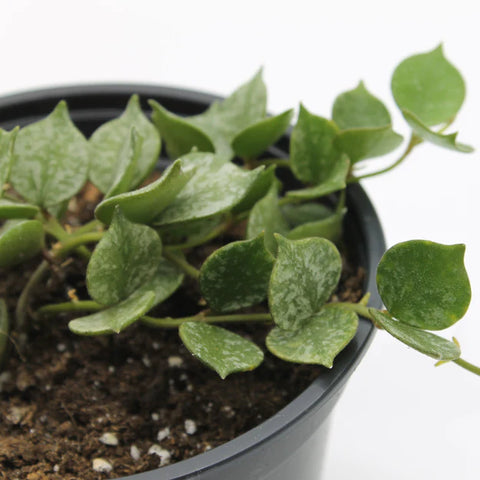
Quick Guide to Hoyas
Understand the Basics and Learn How to Care for your Hoya
What is a Hoya?
Hoya, also known as Wax Plant, is a species of flowering plant that belongs to the Apocynaceae family. These plants are native to tropical and subtropical regions of Asia and Australasia. They are known for their thick, waxy leaves and clusters of small, fragrant flowers that come in a variety of colors such as red, pink, yellow, or white.
Hoyas are popular houseplants because they are easy to care for and can thrive in a wide range of indoor conditions. They prefer bright, indirect sunlight and well-draining soil. They also prefer relatively high humidity, so if your home is dry, you may need to occasionally mist the leaves or place a tray of water near the plant to increase humidity.
Hoyas are also known for their long vining stems and can be trained to climb a trellis or allowed to drape down from a hanging basket. They can be grown as a specimen plant or grouped together to create a lush and verdant display.
Hoya plants are also known for their unique and fragrant flowers, they bloom in clusters and they can give an tropical vibe to any room, they also known to attract butterflies, bees and hummingbirds.
Common Hoyas
Hoya Australis

The Australis loves to vine and climb! It has rounded leaves that are rather thin, not like a succulent. New leaves are typically reddish in colour.
Hoya Carnosa

Hoya Carnosa is THE classic hoya. It has pointed leaves and many sub species.
Hoya Carnosa Tricolor Krimson Princess

This Carnosa is sometimes known as the Carnosa Pink Princess. It features a variegation at the centre of the leaves which can become pink in high light conditions.
Hoya Kerri Heart

This cute Hoya comes shaped like a heart! You’ll also find it in a more rare variegated version.
Hoya Curtisii

The Curtisii has beautiful, tiny leaves shaped like a spade with a gorgeous silvery variegation.
Hoya Pubicalyx Splash

The Pubicalyx Splash has long, wide leaves with silver dashes.
Hoya Sunrise

In high light conditions, this rare Hoya will produce red leaves with green veins.
Hoya Wayetti

The Wayetii has vibrant green elongated leaves with distinctive darker edges that may vary in redness depending on light conditions.
Hoya Plant Care
Caring for a Hoyas can be relatively simple if you understand the plant's basic needs:
Light:
Hoyas prefer bright, indirect sunlight, but can tolerate lower light levels. A east- or west-facing window is ideal. Avoid placing the plant in direct sunlight, as this can cause the leaves to burn or turn yellow.
Water:
Hoyas prefer to be kept consistently moist, but not waterlogged. Water when the soil feels dry to the touch, usually once a week, and make sure to allow the excess water to drain away. In winter, when the plant is dormant, you can reduce watering.
Temperature:
Hoyas like to be kept in warm room temperatures, ideally between 60-85 degrees Fahrenheit. If the temperature drops below 50 degrees Fahrenheit, they can go into dormancy and may lose leaves or stop growing.
Soil:
Hoyas prefer well-draining soil that is high in organic matter. A commercial potting soil for houseplants or cactus and succulent soil is a good option. Hoyas are also sensitive to chlorine and fluoride which can be found in tap water, so if possible, use filtered or rain water.
Humidity:
Hoyas like humidity levels of 50-70%, if your home is dry you may want to increase the humidity level by placing a tray of water near the plant or misting the leaves occasionally.
Fertilizer:
Fertilize your Hoya plant once a month during the growing season with a balanced houseplant fertilizer. Be sure to follow the package instructions for the correct amount to use.
Pruning:
Pinch back the tips of the vines to encourage branching. You can also prune your hoya to keep it a specific size or shape.
Repotting:
Hoya plants don't need to be repotted often, but if you notice that the roots are filling the pot or the plant seems pot-bound, it's time to repot it into a container that is one size larger.
By providing proper light, water, temperature, humidity, and fertilizer, a Hoya plant will grow vigorously, but remember that this is a slow-growing plant so it may take a long time for it to reach maturity. With proper care, a Hoya can be enjoyed for many years and even passed down to future generations as a treasured houseplant.
Flowering
You may need to have more than one of these conditions for blooming to occur.
- You’ll need at least half a day of direct filtered sun to help blooming along.
- Having a root bound plant will also encourage your plant into bloom. Hoyas in general like tighter pots.
- Cooler evening temperatures (not below 10 Celsius, though) will help trigger blooming too.
- A dry rest period of 4-5 weeks during the winter time may also help. Keep an eye on your plant though to make sure that it’s not suffering too much, but Hoyas are pretty drought tolerance and should be OK!
Toxicity
Hoyas are not considered to be toxic or poisonous.
Propagation
Propagating a Hoya is a fairly simple process that can be done in a few different ways. Here are the steps to propagate Hoya using stem cuttings:
- Select a healthy stem from your Hoya plant. Ideally, you should choose a stem that is at least 4 inches long and has at least two leaf nodes (the point on the stem from which leaves grow).
- Cut the stem at a 45-degree angle, just below a leaf node. Make sure to use a sharp and clean scissors or knife for this.
- Remove the leaves from the bottom two-thirds of the stem cutting. This will allow the cutting to form roots more easily.
- Dip the cut end of the stem into rooting hormone powder (optional) to encourage root growth.
- Plant the stem cutting in a small pot or container filled with well-draining potting mix. Make sure the leaf nodes are buried in the soil. Water the cutting lightly, but avoid getting water on the leaves.
- Cover the cutting with a plastic bag or a clear plastic container to create a mini greenhouse effect. This will help to maintain the humidity level and prevent the cutting from drying out.
- Place the pot in a warm and bright location but away from direct sunlight. Keep the soil consistently moist but not waterlogged. It usually takes 2-6 weeks to see roots forming.
- Once you see roots forming and new growth appearing, you can gradually remove the covering, allowing the cutting to acclimate to the normal humidity level before gradually exposing it to more sunlight.
Hoyas can also be propagated by using leaf cuttings. It’s a similar process but instead of using stem cuttings you use a single leaf along with a small piece of stem. The rooting hormone is still optional, and the process is the same but it takes longer for the roots to form and for new growth to appear. It's important to be patient as Hoya may take several weeks or even months to develop roots, but once rooted, they will grow into healthy plants.
Potential Hoya Problems
Mineral Residue

This is from mineral rich water and fertilizer sitting on the leaves, leaving a residue. This will not hurt the plant at all and can be wiped off and polished with neem oil.
Guttation

Guttation occurs when a plant oozes water and minerals out from perfectly healthy leaves, stems, and sometimes even flower petals. For indoor plants, there is a risk when too much guttation occurs. It evaporates and leaves white spots on leaves. It takes place when roots of a plant absorb more water than the plant needs.
To reduce guttation on houseplants, you can do the following.
- avoid watering in the evening.
- water with soft water or rainwater, not mineral-laden hard tap water.
- don’t over-fertilize since it keeps adding minerals to the soil. Better to repot or top dress a plant instead.
- wipe the spots off gently with a soft moist cloth.
Oedema

Oedema is a type of abnormal water retention in plants, often influenced by the plant’s environment. Favourable conditions actually encourage edema in many cases, since affected plants already have a fair amount of water in their systems, providing them with more can just encourage them to gorge on liquid. Any time the plant takes up water faster than it transpires, edema becomes a risk.
Roots tend to absorb water faster when the water is warm and the atmosphere is cool, so wait to water until the sun is up in the morning whenever possible. Indoors, humidity can also have a considerable influence on edema; improving air circulation around plants will help reduce humidity into safer ranges.
Leaf Spot

Leaf spot is a disease that is caused by bacteria and fungi. This usually looks like small, circular black dots that spot your leaves and slowly spread across the plant if left unchecked. Leaf spots generally occur when fungal spores in the air find a plant they can grow on.
To treat leaf-spots, use a copper fungicide to spray the affected leaves of the hoya plant. Copper is a safe option for indoor plants, and you can also find organic fungicides that are safer still. Mix the solution with water and spray it on the leaves. Repeat the process according to the instructions given on the label of the product.
To prevent leaf spots, keep the leaves dry as much as possible. If the plant has been infected, make sure you remove all the infected leaves along with applying the copper fungicide treatment. Inspect the surrounding plants for any signs of infection as the disease is highly contagious.
Conclusion
Once you start caring for a hoya, you’ll have a hard time not getting a second one! Hoya’s are unique plants that are generally easy to care for. They’re grown for their attractive foliage and strongly scented flowers. Hoyas grow well indoors, preferring bright light, but will tolerate fairly low light levels, although they may not flower without bright light. Hoya carnosa has been shown in recent studies at the University of Georgia to be an excellent remover of pollutants in the indoor environment. Once you start caring for a hoya, you’ll have a hard time not getting a second one!
See our selection of Hoya here.
Cactus en Ligne Team
www.cactusenligne.ca ∙ bonjour@cactusenligne.ca
